Recent Photos
Jack Schmidling Productions, Inc.
18016 Church Road ~ Marengo IL 60152
New SLIDE SHOWNew
PHOTO INDEX HOME
TRANSIT OF VENUS
May 5, 2012
This is what Venus looked like about two hours into it's transit of the face of the Sun.
The picture was taken with a Cannon Digital Rebel, a 300 mm lens and a solar filter at about 2330 GMT.
It's not up to my usual standards but as my telescopes are in mothballs, it was the best I could do.
Severl sunspot groups can also be seen in the photo.

ANTIQUE CIRCULAR SOCK MACHINE
This wonderful machine is my Christmas present from Marilyn. It was to the early 20th century what Ebay is today.
Instead of reselling other people's junk, people bought these machines to make socks to sell to anyone including the companies that sold them the machine.
One simply feeds hay into it while turning the crank and out comes endless miles of socks. Well, it helps to have sheep to convert the hay into wool first but that is just a detail.
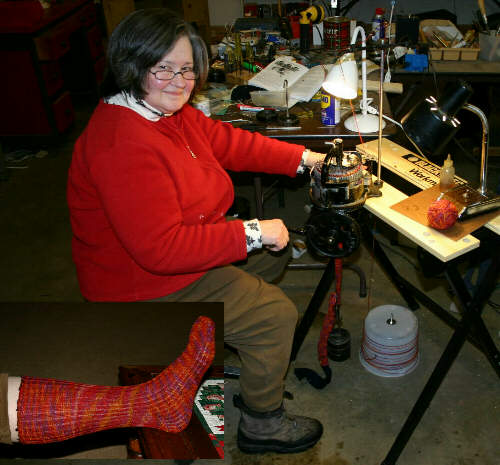
To express my appreciation for this wonderful gift, I gave Marilyn a pair of socks made on the machine.
Just to make it a real family affair, I insisted that she do the cranking.
MERRY CHRISTMAS
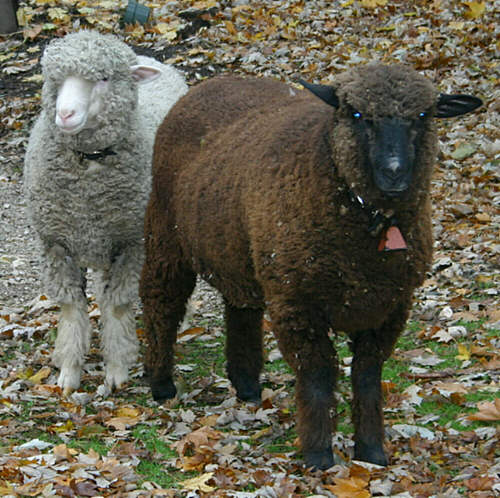
Mr. President Elect
and
Madame Secretary
We always told Bamy if he worked hard he could even be president some day.
We knew Hillary could do better than Senator of NY but never expected her to be working for Bamy.
George of course, is a lame duck and no longer considered a photo op.
For more on Obama and Hillary,.... The Boys
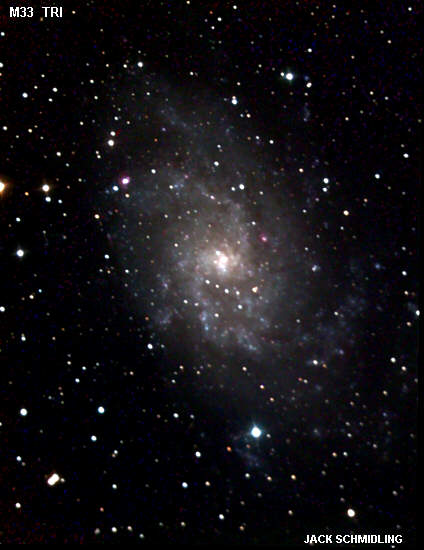
M33
Sprial Galaxy in Triangulum
The Pinwheel is a member of the Local Group of galaxies and is the second closest spiral galalxy after M31 in Andromeda.
It lies at a distance of about 2.4 million light years and is about 50,000 light years across or about half the size of the Milky Way.
The entire spiral rotates in a period of about 200 million years.
For the rest of the story..... M33
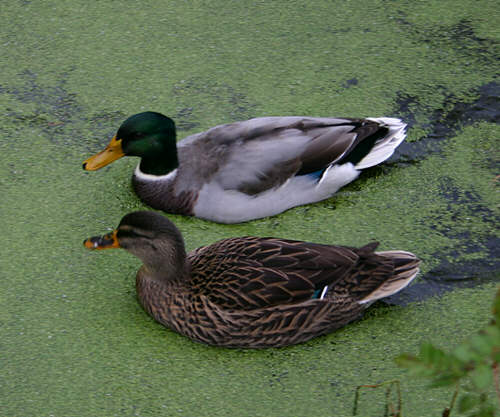
DUCK UPDATE
Here are our little "duckies", all grown up and ready for Winter.
The big question is, what are they going to do about it? Take off with a passing flock and migrate or
just hang around and see what happens.
As can be seen, they haven't had much of an impact on the Duck Weed which was the whole point of the experiment.
We have a bubbler in the pond so there will always be some open water but as the Duck Weed dies off and the water starts to freeze around the margins, they will become more and more dependant upon our feeding them.
So, what will they do when there is only a 3 foot circle of open water?
Place your bets folks.
For the rest of the story..... DUCK WEED

BLACK AND YELLOW GARDEN SPIDER
Argiope aurantia
The Argiopes are conspicuous spiders commonly found in gardens.
In addition to the familiar orb, they add sections of zig-zig for reasons which only the spider knows.
This individual built her (males are much smaller) web on a garden fence and appears about ready to lunch on the insect
wrapped up in the silk.
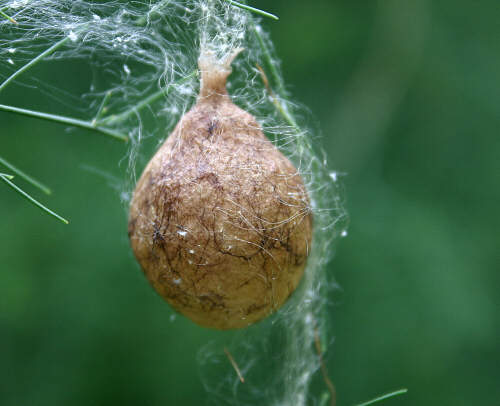
Last week I posted this "Mystery Photo" of an egg sac found in the asparagus garden.
The consensus of readers is that it is indeed, the egg sac produced by a spider like the above.
As the two gardens are about 50 feet apart, I would presume it was made by a different individal.
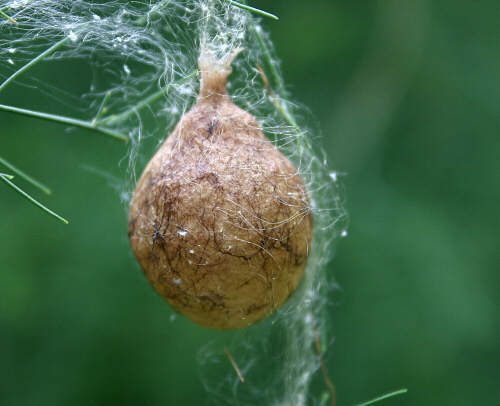
ANOTHER MYSTERY
This page is becoming the Mystery Of the Week.
This nest or cocoon was found on an asparagus plant.
A zoologist friend suggested possibly some kind for wasp but didn't really know. It resembles a Black Widow egg sack but
we have never seen an adult around here.
There was a Black and Yellow Agriope in a web nearby but I don't know what their egg sacs look like.
Any ideas?
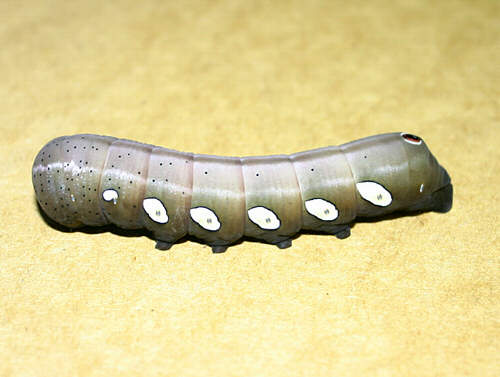
SPHINX LARVA?
Here we have another mystery larva. This one found on the trail, in the grass.
The only thing I see like it in my refs is Pandora Sphinx (Pholus satellitia) but the color is wrong.
Any ideas?
js
Mystery over..... P. satellitia confirmed by several readers.

NGC 7635, THE BUBBLE NEBULA
NGC 7635 is one of the most dramatic objects in the sky. As with the Horsehead Nebula, the name Bubble says it all.
For the complete story and more photos, see:
BUBBLE NEBULA
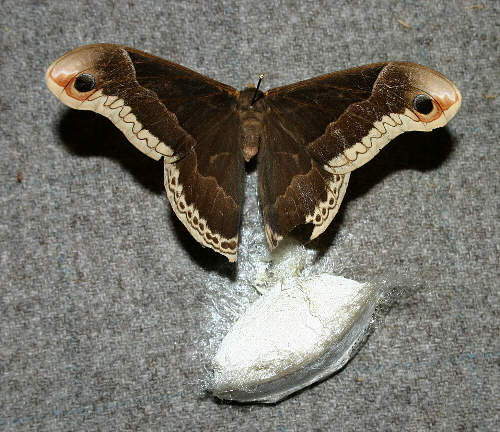
PROMETHEA MOTH
Callosamia promethea
Also known as the Spicebush Moth, the Promethea was used as a substitute for the Giant Silk Moth but was
never commercially practical.
In addition to Spicebush, the larva feeds on Sassafras, Tulip Tree and Wild Cherry.
In case you wonder about the pin through it's body, this specimen was found dead in the neighbor's driveway
so we added it to our collection. Giant Silk Moths are too rare around here to kill for collections.
NOTE........... Turns out this larva and cocoon have nothing to do with Promethea. They are actually Polephemus and I will update the page when I get a chance.
js
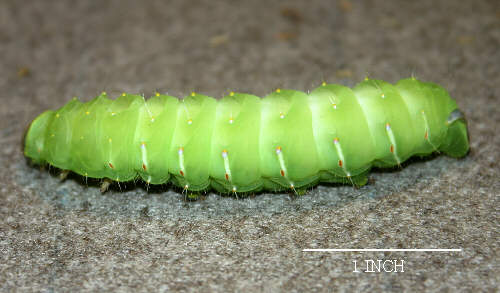
The cocoon in the above picture was spun in situ by this larva found in the pasture.
I set it on the gray background to take a picture and then covered it with a small bowl
to keep it from leaving while I processed the picture.
By the time I came back to release it, it was firmly attached to the wool background
and to the bowl so we left it to complete it's mission.
In the morning, we peeled the bowl off but it is going to spend the Winter on the board.
Hopefully, we will have a live one to photograph in Spring.

TURTLE HEAD
Chelone glabra
Like many members of the Snapdragon family, (Scrophulariaceae)
the
flowers of the Turtlehead resemble something other than flowers.
In this case the resemblance is quite striking.

The wild version is white and native to much of the middle and eastern parts of the US.
This cultivated pink version is a wonderful garden flower as it blooms
in total shade.
This bit of dappled sun is all it gets and only for a few minutes a day.
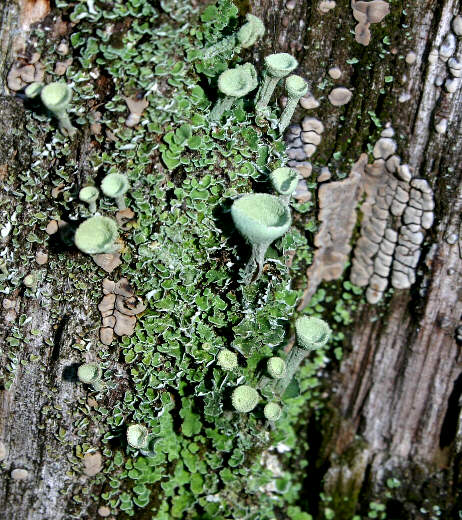
PIXIE-CUP LICHEN
Cladonia chlorophaea
Although a common fruiticose lichen, this is the only group we have found around here.
The fruiting bodies grow out of the edges of the cups.
The gray cracked mass to the right and scattered throughout is also a lichen but I can not seem to find it in my references.
I trust someone from the Chicago Lichenological Society will help me out here.
Here with comments from Rich Hyerczyk, Chicago Lichens
"This particular lichen (the Cladonia chlorophaea
complex) has at least 3 to 4 species that look
identical morphologically, but chemically they differ.
All have cups. This group is identified, species-wise,
base on the acids they contain, not really on cups
size or anything like that. Lichen acids are best
detected using thin-layer chromatography.
Cladonia grayi has grayanic acid
Cladonia chlorophaea has fumarprotocetraric acid
Cladonia cryptochlorophaea has cryptochlorophaeic acid
And so onÖ
So, I really donít know what species you show, only
that it is a Cladonia. I guess calling it Cladonia
chlorophaea (pixie-cup lichen) is fine too.
2. The gray cracked mass growing with the Cladonia is
a fungus (non-lichenized) and is called Xylobolus
frustulatus (ceramic parchment fungus). Usually found
on the ends of sawed oak logs. "
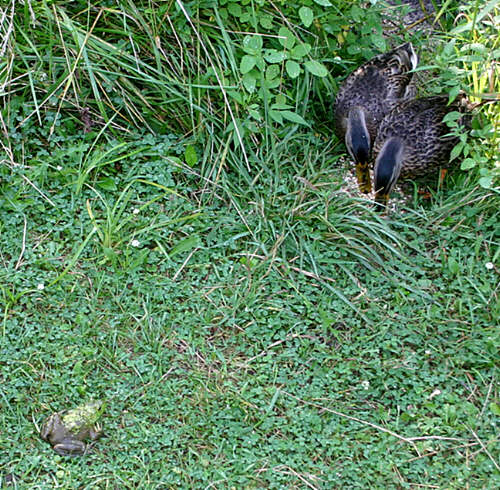
A MATTER OF TASTE
This scene takes place at the edge of our pond where we put a little chicken scratch down for our Mallards every morning.
It is not unusual to find a frog sitting on the bare spot where we put it. He usually hops away but this time he seems to be wondering why anyone would want to eat this stuff.
For the past few weeks, the ducks have been following us part way back to the house and then they take off and fly back to the pond. One of them is a very good flyer but the other barely gets off the ground.

ANOTHER MYSTERY
My first reaction to seeing this was bird poop.
Upon closer examination, it is the true color of the leaves of this VERY white clover.
There a few other similar cases in the general area where these are.
I suspect some sort of fungus but would appreciate it if someone could identify it.
js
To see all of our photos for the past 10 years in slide show format, click on link below.
New SLIDE SHOWNew


M33
Sprial Galaxy in Triangulum
The Pinwheel is a member of the Local Group of galaxies and is the second closest spiral galalxy after M31 in Andromeda.
It lies at a distance of about 2.4 million light years and is about 50,000 light years across or about half the size of the Milky Way.
The entire spiral rotates in a period of about 200 million years.

DUCK UPDATE
Here are our little "duckies", all grown up and ready for Winter.
The big question is, what are they going to do about it? Take off with a passing flock and migrate or
just hang around and see what happens.
As can be seen, they haven't had much of an impact on the Duck Weed which was the whole point of the experiment.
We have a bubbler in the pond so there will always be some open water but as the Duck Weed dies off and the water starts to freeze around the margins, they will become more and more dependant upon our feeding them.
Place your bets folks.

BLACK AND YELLOW GARDEN SPIDER
Argiope aurantia
The Argiopes are conspicuous spiders commonly found in gardens.
In addition to the familiar orb, they add sections of zig-zig for reasons which only the spider knows.
This individual built her (males are much smaller) web on a garden fence and appears about ready to lunch on the insect
wrapped up in the silk.

Last week I posted this "Mystery Photo" of an egg sac found in the asparagus garden.
The consensus of readers is that it is indeed, the egg sac produced by a spider like the above.
As the two gardens are about 50 feet apart, I would presume it was made by a different individal.

ANOTHER MYSTERY
This page is becoming the Mystery Of the Week.
This nest or cocoon was found on an asparagus plant.
A zoologist friend suggested possibly some kind for wasp but didn't really know. It resembles a Black Widow egg sack but
we have never seen an adult around here.
There was a Black and Yellow Agriope in a web nearby but I don't know what their egg sacs look like.
Any ideas?

SPHINX LARVA?
Here we have another mystery larva. This one found on the trail, in the grass.
The only thing I see like it in my refs is Pandora Sphinx (Pholus satellitia) but the color is wrong.
Any ideas?
js
Mystery over..... P. satellitia confirmed by several readers.

NGC 7635, THE BUBBLE NEBULA
NGC 7635 is one of the most dramatic objects in the sky. As with the Horsehead Nebula, the name Bubble says it all.
For the complete story and more photos, see:
BUBBLE NEBULA

PROMETHEA MOTH
Callosamia promethea
Also known as the Spicebush Moth, the Promethea was used as a substitute for the Giant Silk Moth but was
never commercially practical.
In addition to Spicebush, the larva feeds on Sassafras, Tulip Tree and Wild Cherry.
In case you wonder about the pin through it's body, this specimen was found dead in the neighbor's driveway
so we added it to our collection. Giant Silk Moths are too rare around here to kill for collections.
NOTE........... Turns out this larva and cocoon have nothing to do with Promethea. They are actually Polephemus and I will update the page when I get a chance.
js

The cocoon in the above picture was spun in situ by this larva found in the pasture.
I set it on the gray background to take a picture and then covered it with a small bowl
to keep it from leaving while I processed the picture.
By the time I came back to release it, it was firmly attached to the wool background
and to the bowl so we left it to complete it's mission.
In the morning, we peeled the bowl off but it is going to spend the Winter on the board.
Hopefully, we will have a live one to photograph in Spring.

TURTLE HEAD
Chelone glabra
Like many members of the Snapdragon family, (Scrophulariaceae)
the
flowers of the Turtlehead resemble something other than flowers.
In this case the resemblance is quite striking.

The wild version is white and native to much of the middle and eastern parts of the US.
This cultivated pink version is a wonderful garden flower as it blooms
in total shade.
This bit of dappled sun is all it gets and only for a few minutes a day.

PIXIE-CUP LICHEN
Cladonia chlorophaea
Although a common fruiticose lichen, this is the only group we have found around here.
The fruiting bodies grow out of the edges of the cups.
The gray cracked mass to the right and scattered throughout is also a lichen but I can not seem to find it in my references.
I trust someone from the Chicago Lichenological Society will help me out here.
Here with comments from Rich Hyerczyk, Chicago Lichens
"This particular lichen (the Cladonia chlorophaea
complex) has at least 3 to 4 species that look
identical morphologically, but chemically they differ.
All have cups. This group is identified, species-wise,
base on the acids they contain, not really on cups
size or anything like that. Lichen acids are best
detected using thin-layer chromatography.
Cladonia grayi has grayanic acid
Cladonia chlorophaea has fumarprotocetraric acid
Cladonia cryptochlorophaea has cryptochlorophaeic acid
And so onÖ
So, I really donít know what species you show, only
that it is a Cladonia. I guess calling it Cladonia
chlorophaea (pixie-cup lichen) is fine too.
2. The gray cracked mass growing with the Cladonia is
a fungus (non-lichenized) and is called Xylobolus
frustulatus (ceramic parchment fungus). Usually found
on the ends of sawed oak logs. "

A MATTER OF TASTE
This scene takes place at the edge of our pond where we put a little chicken scratch down for our Mallards every morning.
It is not unusual to find a frog sitting on the bare spot where we put it. He usually hops away but this time he seems to be wondering why anyone would want to eat this stuff.
For the past few weeks, the ducks have been following us part way back to the house and then they take off and fly back to the pond. One of them is a very good flyer but the other barely gets off the ground.

ANOTHER MYSTERY
My first reaction to seeing this was bird poop.
Upon closer examination, it is the true color of the leaves of this VERY white clover.
There a few other similar cases in the general area where these are.
I suspect some sort of fungus but would appreciate it if someone could identify it.
js
To see all of our photos for the past 10 years in slide show format, click on link below.
New SLIDE SHOWNew

NOTE........... Turns out this larva and cocoon have nothing to do with Promethea. They are actually Polephemus and I will update the page when I get a chance.
js

The cocoon in the above picture was spun in situ by this larva found in the pasture.
I set it on the gray background to take a picture and then covered it with a small bowl
to keep it from leaving while I processed the picture.
By the time I came back to release it, it was firmly attached to the wool background
and to the bowl so we left it to complete it's mission.
In the morning, we peeled the bowl off but it is going to spend the Winter on the board.
Hopefully, we will have a live one to photograph in Spring.

TURTLE HEAD
Chelone glabra
Like many members of the Snapdragon family, (Scrophulariaceae)
the
flowers of the Turtlehead resemble something other than flowers.
In this case the resemblance is quite striking.

The wild version is white and native to much of the middle and eastern parts of the US.
This cultivated pink version is a wonderful garden flower as it blooms
in total shade.
This bit of dappled sun is all it gets and only for a few minutes a day.

PIXIE-CUP LICHEN
Cladonia chlorophaea
Although a common fruiticose lichen, this is the only group we have found around here.
The fruiting bodies grow out of the edges of the cups.
The gray cracked mass to the right and scattered throughout is also a lichen but I can not seem to find it in my references.
I trust someone from the Chicago Lichenological Society will help me out here.
Here with comments from Rich Hyerczyk, Chicago Lichens
"This particular lichen (the Cladonia chlorophaea
complex) has at least 3 to 4 species that look
identical morphologically, but chemically they differ.
All have cups. This group is identified, species-wise,
base on the acids they contain, not really on cups
size or anything like that. Lichen acids are best
detected using thin-layer chromatography.
Cladonia grayi has grayanic acid
Cladonia chlorophaea has fumarprotocetraric acid
Cladonia cryptochlorophaea has cryptochlorophaeic acid
And so onÖ
So, I really donít know what species you show, only
that it is a Cladonia. I guess calling it Cladonia
chlorophaea (pixie-cup lichen) is fine too.
2. The gray cracked mass growing with the Cladonia is
a fungus (non-lichenized) and is called Xylobolus
frustulatus (ceramic parchment fungus). Usually found
on the ends of sawed oak logs. "

A MATTER OF TASTE
This scene takes place at the edge of our pond where we put a little chicken scratch down for our Mallards every morning.
It is not unusual to find a frog sitting on the bare spot where we put it. He usually hops away but this time he seems to be wondering why anyone would want to eat this stuff.
For the past few weeks, the ducks have been following us part way back to the house and then they take off and fly back to the pond. One of them is a very good flyer but the other barely gets off the ground.

ANOTHER MYSTERY
My first reaction to seeing this was bird poop.
Upon closer examination, it is the true color of the leaves of this VERY white clover.
There a few other similar cases in the general area where these are.
I suspect some sort of fungus but would appreciate it if someone could identify it.
js
To see all of our photos for the past 10 years in slide show format, click on link below.
New SLIDE SHOWNew


TURTLE HEAD
Chelone glabra
Like many members of the Snapdragon family, (Scrophulariaceae)
the
flowers of the Turtlehead resemble something other than flowers.
In this case the resemblance is quite striking.

The wild version is white and native to much of the middle and eastern parts of the US.
This cultivated pink version is a wonderful garden flower as it blooms
in total shade.
This bit of dappled sun is all it gets and only for a few minutes a day.

PIXIE-CUP LICHEN
Cladonia chlorophaea
Although a common fruiticose lichen, this is the only group we have found around here.
The fruiting bodies grow out of the edges of the cups.
The gray cracked mass to the right and scattered throughout is also a lichen but I can not seem to find it in my references.
I trust someone from the Chicago Lichenological Society will help me out here.
Here with comments from Rich Hyerczyk, Chicago Lichens
"This particular lichen (the Cladonia chlorophaea
complex) has at least 3 to 4 species that look
identical morphologically, but chemically they differ.
All have cups. This group is identified, species-wise,
base on the acids they contain, not really on cups
size or anything like that. Lichen acids are best
detected using thin-layer chromatography.
Cladonia grayi has grayanic acid
Cladonia chlorophaea has fumarprotocetraric acid
Cladonia cryptochlorophaea has cryptochlorophaeic acid
And so onÖ
So, I really donít know what species you show, only
that it is a Cladonia. I guess calling it Cladonia
chlorophaea (pixie-cup lichen) is fine too.
2. The gray cracked mass growing with the Cladonia is
a fungus (non-lichenized) and is called Xylobolus
frustulatus (ceramic parchment fungus). Usually found
on the ends of sawed oak logs. "

A MATTER OF TASTE
This scene takes place at the edge of our pond where we put a little chicken scratch down for our Mallards every morning.
It is not unusual to find a frog sitting on the bare spot where we put it. He usually hops away but this time he seems to be wondering why anyone would want to eat this stuff.
For the past few weeks, the ducks have been following us part way back to the house and then they take off and fly back to the pond. One of them is a very good flyer but the other barely gets off the ground.

ANOTHER MYSTERY
My first reaction to seeing this was bird poop.
Upon closer examination, it is the true color of the leaves of this VERY white clover.
There a few other similar cases in the general area where these are.
I suspect some sort of fungus but would appreciate it if someone could identify it.
js
To see all of our photos for the past 10 years in slide show format, click on link below.
New SLIDE SHOWNew


The wild version is white and native to much of the middle and eastern parts of the US.
This cultivated pink version is a wonderful garden flower as it blooms
in total shade.
This bit of dappled sun is all it gets and only for a few minutes a day.

PIXIE-CUP LICHEN
Cladonia chlorophaea
Although a common fruiticose lichen, this is the only group we have found around here.
The fruiting bodies grow out of the edges of the cups.
The gray cracked mass to the right and scattered throughout is also a lichen but I can not seem to find it in my references.
I trust someone from the Chicago Lichenological Society will help me out here.
Here with comments from Rich Hyerczyk, Chicago Lichens
"This particular lichen (the Cladonia chlorophaea
complex) has at least 3 to 4 species that look
identical morphologically, but chemically they differ.
All have cups. This group is identified, species-wise,
base on the acids they contain, not really on cups
size or anything like that. Lichen acids are best
detected using thin-layer chromatography.
Cladonia grayi has grayanic acid
Cladonia chlorophaea has fumarprotocetraric acid
Cladonia cryptochlorophaea has cryptochlorophaeic acid
And so onÖ
So, I really donít know what species you show, only
that it is a Cladonia. I guess calling it Cladonia
chlorophaea (pixie-cup lichen) is fine too.
2. The gray cracked mass growing with the Cladonia is
a fungus (non-lichenized) and is called Xylobolus
frustulatus (ceramic parchment fungus). Usually found
on the ends of sawed oak logs. "

A MATTER OF TASTE
This scene takes place at the edge of our pond where we put a little chicken scratch down for our Mallards every morning.
It is not unusual to find a frog sitting on the bare spot where we put it. He usually hops away but this time he seems to be wondering why anyone would want to eat this stuff.
For the past few weeks, the ducks have been following us part way back to the house and then they take off and fly back to the pond. One of them is a very good flyer but the other barely gets off the ground.

ANOTHER MYSTERY
My first reaction to seeing this was bird poop.
Upon closer examination, it is the true color of the leaves of this VERY white clover.
There a few other similar cases in the general area where these are.
I suspect some sort of fungus but would appreciate it if someone could identify it.
js
To see all of our photos for the past 10 years in slide show format, click on link below.
New SLIDE SHOWNew


PIXIE-CUP LICHEN
Cladonia chlorophaea
Although a common fruiticose lichen, this is the only group we have found around here.
The fruiting bodies grow out of the edges of the cups.
The gray cracked mass to the right and scattered throughout is also a lichen but I can not seem to find it in my references.
I trust someone from the Chicago Lichenological Society will help me out here.
Here with comments from Rich Hyerczyk, Chicago Lichens
"This particular lichen (the Cladonia chlorophaea
complex) has at least 3 to 4 species that look
identical morphologically, but chemically they differ.
All have cups. This group is identified, species-wise,
base on the acids they contain, not really on cups
size or anything like that. Lichen acids are best
detected using thin-layer chromatography.
Cladonia grayi has grayanic acid
Cladonia chlorophaea has fumarprotocetraric acid
Cladonia cryptochlorophaea has cryptochlorophaeic acid
And so onÖ
So, I really donít know what species you show, only
that it is a Cladonia. I guess calling it Cladonia
chlorophaea (pixie-cup lichen) is fine too.
2. The gray cracked mass growing with the Cladonia is
a fungus (non-lichenized) and is called Xylobolus
frustulatus (ceramic parchment fungus). Usually found
on the ends of sawed oak logs. "

A MATTER OF TASTE
This scene takes place at the edge of our pond where we put a little chicken scratch down for our Mallards every morning.
It is not unusual to find a frog sitting on the bare spot where we put it. He usually hops away but this time he seems to be wondering why anyone would want to eat this stuff.
For the past few weeks, the ducks have been following us part way back to the house and then they take off and fly back to the pond. One of them is a very good flyer but the other barely gets off the ground.

ANOTHER MYSTERY
My first reaction to seeing this was bird poop.
Upon closer examination, it is the true color of the leaves of this VERY white clover.
There a few other similar cases in the general area where these are.
I suspect some sort of fungus but would appreciate it if someone could identify it.
js
To see all of our photos for the past 10 years in slide show format, click on link below.
New SLIDE SHOWNew

"This particular lichen (the Cladonia chlorophaea complex) has at least 3 to 4 species that look identical morphologically, but chemically they differ. All have cups. This group is identified, species-wise, base on the acids they contain, not really on cups size or anything like that. Lichen acids are best detected using thin-layer chromatography.
Cladonia grayi has grayanic acid Cladonia chlorophaea has fumarprotocetraric acid Cladonia cryptochlorophaea has cryptochlorophaeic acid And so onÖ
So, I really donít know what species you show, only that it is a Cladonia. I guess calling it Cladonia chlorophaea (pixie-cup lichen) is fine too.
2. The gray cracked mass growing with the Cladonia is a fungus (non-lichenized) and is called Xylobolus frustulatus (ceramic parchment fungus). Usually found on the ends of sawed oak logs. "

A MATTER OF TASTE
This scene takes place at the edge of our pond where we put a little chicken scratch down for our Mallards every morning.
It is not unusual to find a frog sitting on the bare spot where we put it. He usually hops away but this time he seems to be wondering why anyone would want to eat this stuff.
For the past few weeks, the ducks have been following us part way back to the house and then they take off and fly back to the pond. One of them is a very good flyer but the other barely gets off the ground.

ANOTHER MYSTERY
My first reaction to seeing this was bird poop.
Upon closer examination, it is the true color of the leaves of this VERY white clover.
There a few other similar cases in the general area where these are.
I suspect some sort of fungus but would appreciate it if someone could identify it.
js
To see all of our photos for the past 10 years in slide show format, click on link below.
New SLIDE SHOWNew


ANOTHER MYSTERY
My first reaction to seeing this was bird poop.
Upon closer examination, it is the true color of the leaves of this VERY white clover.
There a few other similar cases in the general area where these are.
I suspect some sort of fungus but would appreciate it if someone could identify it.
js
To see all of our photos for the past 10 years in slide show format, click on link below.
New SLIDE SHOWNew

To see all of our photos for the past 10 years in slide show format, click on link below.
New SLIDE SHOWNew
